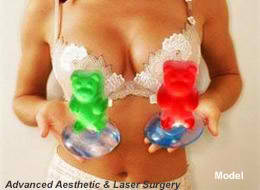‘Gummy Bear’ Implants Are Not What They Were Cracked Up To Be
 The term ‘gummy bear’ implants arose several years ago when the two largest breast implant companies, Allergan and Mentor, began to develop silicone implants with more viscosity; that is, a thicker gel than what has been used in the past. Breast implant experts refer to the thickness of the gel as ‘cohesiveness.’ The more cohesive the gel, the more the implant retains its shape regardless of whether or not the implant shell is intact.
The term ‘gummy bear’ implants arose several years ago when the two largest breast implant companies, Allergan and Mentor, began to develop silicone implants with more viscosity; that is, a thicker gel than what has been used in the past. Breast implant experts refer to the thickness of the gel as ‘cohesiveness.’ The more cohesive the gel, the more the implant retains its shape regardless of whether or not the implant shell is intact.
The first silicone implants that were used for breast augmentation had a very thin gel and a very thin shell. As a result, they had a very liquid feel similar to thick oil. There were several problems with these implants including bleeding of the gel through the implant shell, rupture, rippling and capsular contracture. The latter is caused by the scar tissue around the implant shrinking resulting in the implant getting compressed and hard. The vast majority of patients with these implants eventually developed severe capsular contractures, implant ruptures or both.
The FDA reapproved silicone gel breast implants in November 2006 for use in the general population for breast augmentation in women over the age of 22 and for breast reconstruction. These implants have thicker shells and a more cohesive gel than their predecessors and very little, if any, leakage of silicone through the shell. They are not as cohesive, however, as the next generation of breast implants that have been nicknamed ‘gummy bear’ implants.
These new highly cohesive implants are now approved by the FDA and are available for general use. They are firmer than standard silicone implants so the feel is not as natural. They are all shaped implants and are therefore textured to try and prevent turning inside of the breast pocket. For these reasons and the fact that they are considerably more expensive than standard silicone gel implants, most plastic surgeons do not use them much for breast enhancement surgery.
Contact Us
Contact Us to speak discuss the best option for you during a consultation.